How Many Japanese Magnolia Tree Varieties Are There?
With Multiple Hybrids and Cultivars, The Most Common Ones are Ann, Jane, Royal Star, Bigleaf, and Kobus Magnolia
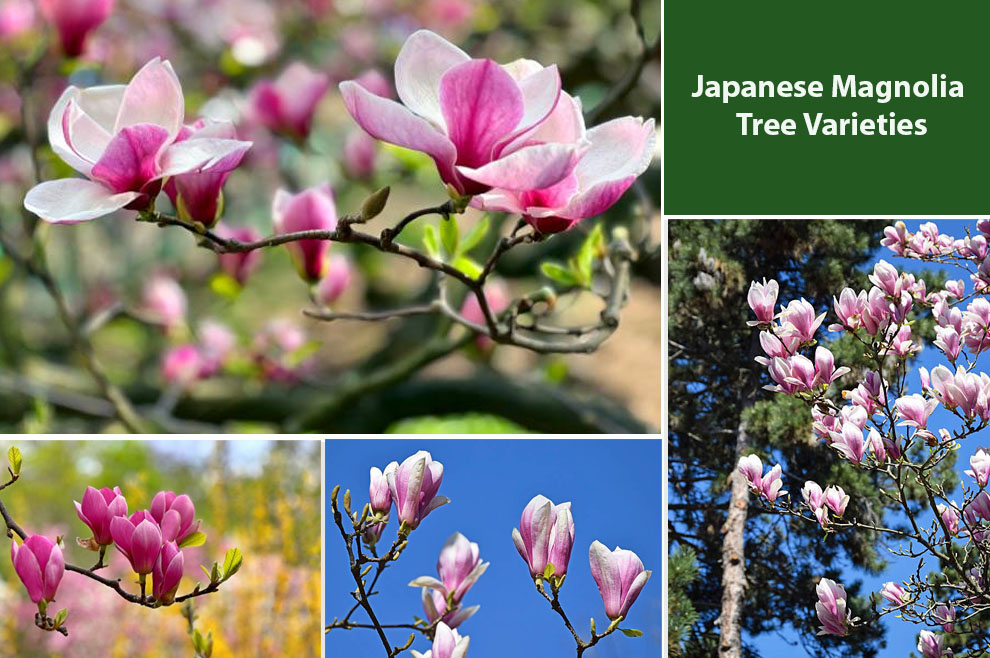
If you are looking to create an attractive outdoor space in your home, don’t forget to add the beautiful Japanese magnolia tree. It is a must-have tree featuring spectacular flowers in vibrant colors.
You can find a large number of spectacular Japanese magnolia varieties to pick from. This deciduous tree is known for its varieties like lily, bigleaf, Kobus, star, tulip, and ann magnolia.
Here we’ve gathered a list of favorite Japanese magnolia trees. You can make your pick and provide the favorable conditions for your Japanese magnolia tree to grow.
Japanese Magnolia Overview
| Scientific name | Magnolia × soulangeana |
| Native to | Asia |
| Mature size | 20 – 25 feet height, 15 – 20 feet width |
| Sunlight required | Full, partial |
| Type of Soil | Well-drained, moist |
| Hardiness Zone | 4 to 9 (USDA) |
Different Types of Japanese Magnolia Trees
- Ann Japanese Magnolia
- Alexandrina Magnolia
- Royal Star Magnolia
- Saucer Mangnolia
- Butterfly Japanese Magnolia
- Lily Mangnolia
- Lennei Magnolia
- Jane Japanese Magnolia
- Kobus Magnolia
- Bigleaf Magnolia
Kinds of Japanese Magnolia Trees – (Popular Hybrid Cultivars)
Japanese magnolia is a famous flowering tree that blooms in different attractive shades like purple, white, dark pink, and light pink. Not only it will make your yard showy and enchanted but also be perfumed with its lovely scent.
The deep green foliage and greyish-silver bark of Japanese magnolia will brighten up your yard even in its non-flowering period.
No matter what type of landscape you want to create, the magnolia tree varieties will be a perfect option. But with so many available varieties, it can be difficult to choose one. So, we’ve rounded up some most popular magnolia cultivars and discussed them in brief.
A. Ann Japanese Magnolia
| Mature size | 8-10’ high, 10’ wide |
| Soil type | Acidic, moist, loamy, well drained |
| Hardiness zone | 4 – 7 |
These small Japanese magnolia trees are perfect for compact gardens or yards. It is a part of the “Little Girl” series of hybrid magnolia cultivars. The best feature of this tree is dark red and purple flowers that make it look like a tulip.
It has somewhat leather-like and dark green leaves that give an ornamental appearance to it. So, whether you grow it as a container shrub or border plant, it will enhance your landscape.
B. Alexandrina Magnolia
| Mature size | 20-25 ft high, 20-25 ft wide |
| Soil type | Slightly acidic soil |
| Hardiness zone | 5 – 9 |
Looking for a stunning flowering shrub to make your garden area more attractive? Try planting one of these beautiful Japanese magnolia varieties. It is highly valuable for its striking white and pinkish-purple flowers that appear like a goblet in shape. It appears more charming in the fall months as the leaves turn yellow. You can expect this tree to bloom flowers in late winter through early spring months.
C. Royal Star Magnolia
| Mature size | 10-12’ high, 10-15’ wide |
| Soil type | Well-drained |
| Hardiness zone | 4-9 |
The flowers of this shrub are so unique that they will add a special appeal to your garden. Royal star blooms massive white flowers from light pink buds. You can notice these eye-catching flowers at the beginning of the spring season.
Apart from this, its smooth and lush green foliage will make your garden outstanding. The best time to plant star magnolia species is when it is dormant i.e. late fall or winter.
D. Saucer Mangnolia
| Mature size | 10-12’ high, 10-15’ wide |
| Soil type | Well-drained |
| Hardiness zone | 4-9 |
| Mature size | 20 – 30’ tall, 20 – 25’ wide |
| Soil type | Acidic, loamy, well-drained, clay and moist soils |
| Hardiness zone | 4 – 9 |
Saucer magnolia is one of the most unique Japanese magnolia tree varieties. It is given the term “saucer” because of its saucer-like flowers. It has wonderfully fragrant flowers which blossom in the early spring season. You can find them in charming shades of white, light pink, purplish pink, and deep pink.
Even the silver and gray shaded bark of the tree gives it a fancy look. The tree has massive broad leaves and prefers to grow in acidic to moist soil.
E. Butterfly Japanese Magnolia
| Mature size | 15 – 30 feet high, 15 – 30 feet wide |
| Soil type | Well-drained, moist soil |
| Hardiness zone | 5 – 9 |
Butterfly Japanese magnolia trees produce stunning yellow flowers indicating the arrival of spring. The deciduous shrub got its name because its flower appears like a butterfly as it fully blooms. It is also adored for its lemon fragrance. Don’t miss pruning your butterfly magnolia when it has full-grown leaves, usually in the mid-summer months.
F. Lily Mangnolia
| Mature size | 8 – 12’ tall, 8 – 12’ wide |
| Soil type | Moist and well-drained |
| Hardiness zone | 5 – 8 |
This wonderful Japanese magnolia varieties belong to parts of Asia. Not only it has a striking appearance but also round and compact structure. That’s why it is frequently chosen to add a beautiful appeal to garden borders. However, you can also use it as a container plant due to its smaller size. The flowers of this deciduous tree blossom in appealing shades of pink and purple.
G. Lennei Magnolia
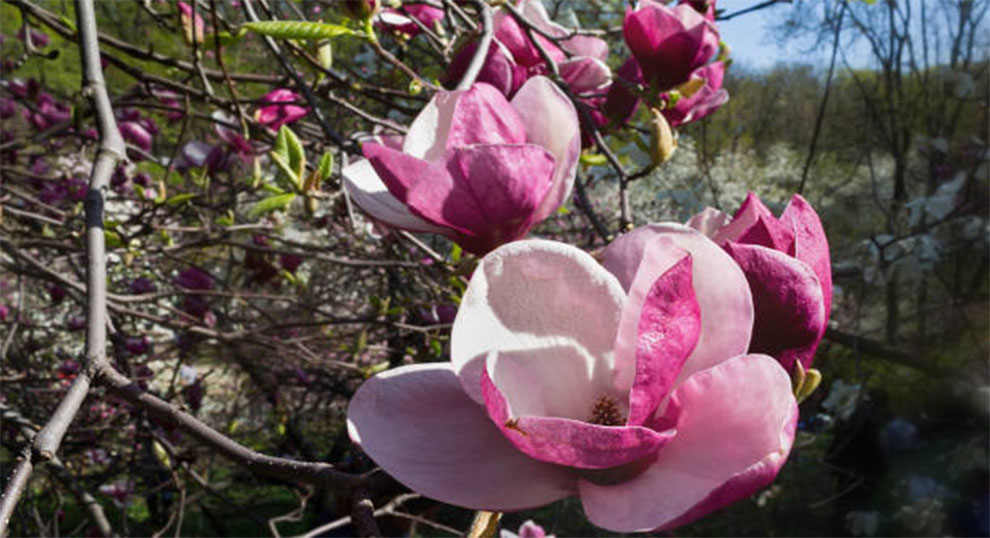
| Mature size | 20 – 25’ tall, 20 – 25’ wide |
| Soil type | Acidic, loamy, well-drained, clay and moist soils |
| Hardiness zone | 4 – 9 |
In contrast to many other Japanese magnolia tree varieties, Lennie magnolia is smaller in size. However, the deciduous magnolia shrub is widely liked for its fast-spreading foliage and fragrant flowers. You can identify its lovely flowers with their goblet form and unique purple-white color.
You can see this plant flowering at the beginning or middle of the spring season. Again don’t forget to prune as soon as you see full-grown leaves on these trees, usually In midsummer months.
H. Jane Japanese Magnolia
| Mature size | 8 – 12’ tall, 8 – 12’ wide |
| Soil type | Moist and well-drained |
| Hardiness zone | 5 – 8 |
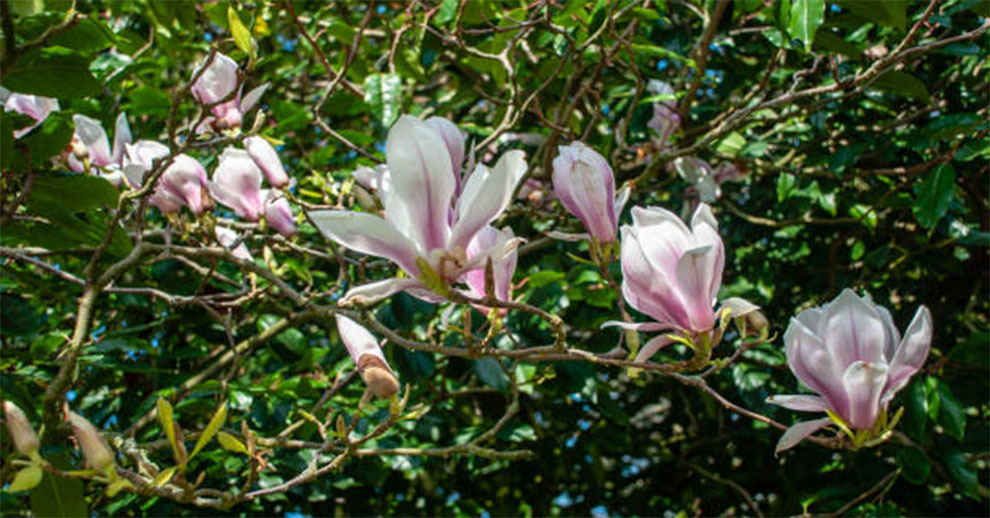
| Mature size | 20 – 25’ tall, 20 – 25’ wide |
| Soil type | Acidic, loamy, well-drained, clay and moist soils |
| Hardiness zone | 4 – 9 |
It is a popular Japanese hybrid magnolia tree liked for its stunning purple flowers. So if you are looking to add an elegant plant to your yard, jane magnolia is your right pick. It grows a beautiful flower in late winter through the beginning of spring. You can identify them by their tulip-like flower. As it flowers bloom fully, the purple color on the outside of the petals turns to pink.
I. Kobus Magnolia
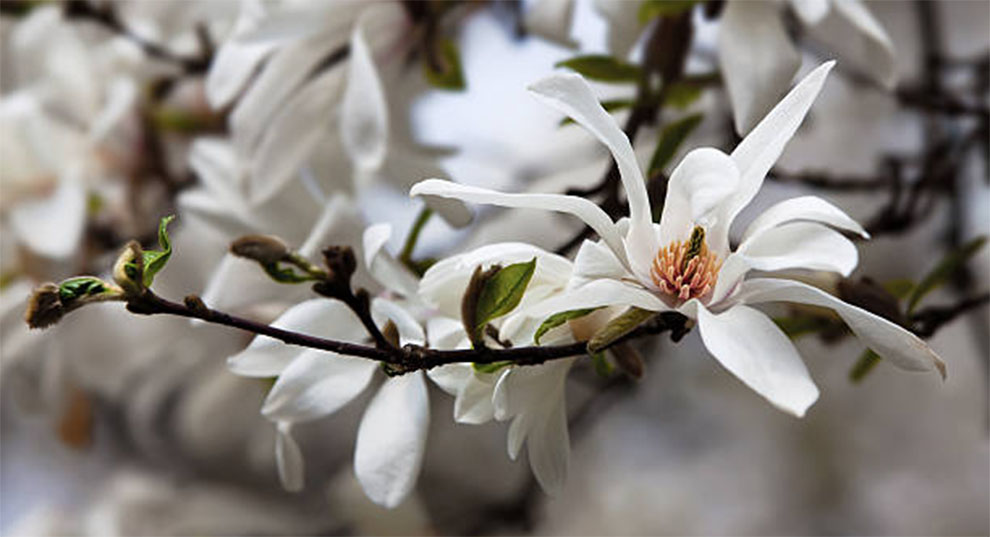
| Mature size | 30 – 50 feet high and 30 feet in width |
| Soil type | Well-drained, rich, loamy |
| Hardiness zone | 5 – 8 |
Kobus magnolia is a majestic deciduous shrub commonly grown by homeowners to enhance their gardens. It has gained popularity because of its lovely white fragrant flowers. It has egg-shaped, large leaves which flaunt their dark green color.
The leaves are 3 to 8 inches in length and turn yellow-brown in autumn. The flowers of this tree bloom at the beginning of the spring season just before its leaves appear.
J. Bigleaf Magnolia
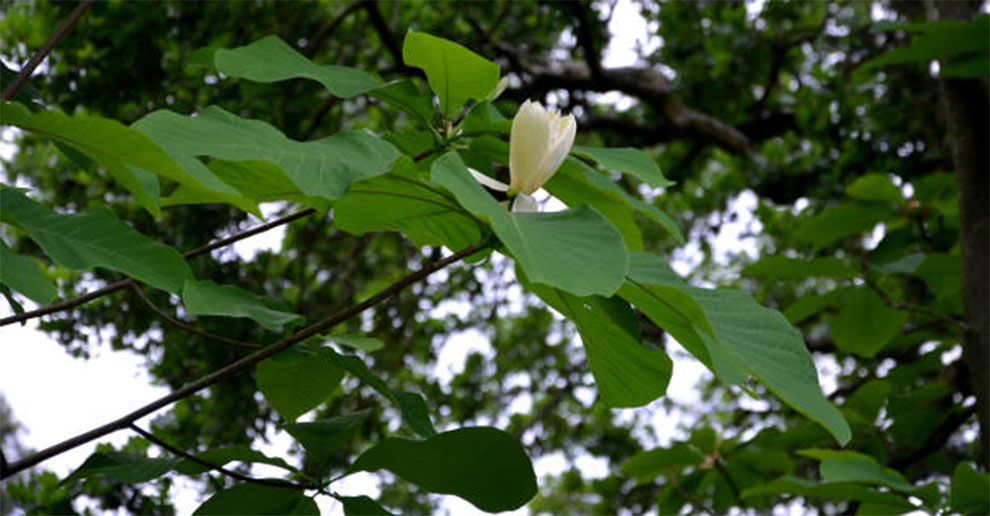
| Mature size | 30 to 40 ft high, 20 to 25 ft wide |
| Soil type | Well-drained, loamy, moist |
| Hardiness zone | 5 – 8 |
Also known as Magnolia Macrophylla, this can be a lovely plant for your yard or garden. You can identify it by its large obovate leaves which can spread about one to three feet long. The top of the leaves is slightly green while the undersides are silverish.
The best time to plant these trees is early spring or fall months. The lovely red fruits of bigleaf magnolia also visually appeal to wildlife and birds.
Related: Magnolia tree growth rate |Evergreen magnolia varieties | Tulip Tree Growth Rate
Other Snake Plant Varieties
Apart from the ones we have stated above, there are many other Japanese magnolia varieties. Some of them are listed below:
- Rustica Rubra Magnolia
- Lennei Alba Magnolia
- Verbanica Magnolia
- Southern Magnolia
- Chinese Magnolia
- Sweetbay Magnolia
- Yulan Magnolia
- Loebner Magnolia
- Leonard Messel Magnolia
- Felix Magnolia
- Umbrella Magnolia
- Star Magnolia
What Is The Most Beautiful Magnolia Tree?
Yulan Magnolia (scientifically known as magnolia denudata) is one of the prettiest Japanese magnolia tree varieties. It can be found as a large deciduous shrub or small tree.
Before spreading its leaves, yulan magnolia grows lovely flowers in creamy and ivory white shades. When borne, it has upright flowers in the shape of a cup. On reaching the mature stage, these flowers open up their petals.
It can grow in hardiness zones 6 to 9. These types of magnolias are highly famous in Chinese homes.
What Is The Rarest Magnolia?
Among the different types of Japanese magnolia trees, Magnolia Zenii, commonly known as Zen magnolia is the rarest. It is part of the Magnoliaceae family. This small deciduous tree is originally from Chinese forests.
This attractively small tree is perfect for people looking for keeping plants in their patio or courtyard. In winter months, it grows beautiful flowers with stunning gray bark which makes it perfectly attractive for winter gardens.
It has an upright structure with a mature size of 15 – 25’ height and 10 – 15’ width. It produces small perfumed flowers which bloom starting from mid-winter to late winter months.
FAQs
Q. How big does a Japanese magnolia get?
Ans. The Japanese magnolias are wonderful trees to be used as landscape specimens or container plants. These varieties generally grow to as big as 15 to 25 feet high. Aside from this, they can spread about 10 to 15 feet wide. But of course, there are exceptions like the Bigleaf and Kobus magnolia that grow up to 40- 50 feet high.
Q. Are Japanese magnolias fast growing?
Ans. The average growth rate of Japanese magnolia varietiesis moderate. It grows just about 12 to 24 inches in every growing season. When you provide magnolia tree with ideal growing conditions and care, it will thrive.
Q. Are Japanese magnolias invasive?
Ans. Generally, the roots of magnolia trees grow horizontally into the ground and offer stability to the tree. Its root system can spread about 4 times that of the branch width. While the rope-like roots of the tree are not usually invasive when planted under suitable conditions, if planted near the house walls, it might create foundational problems and also obstruct the tree’s growth.
